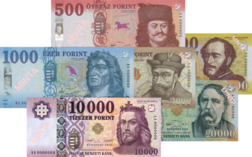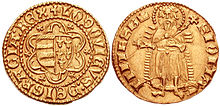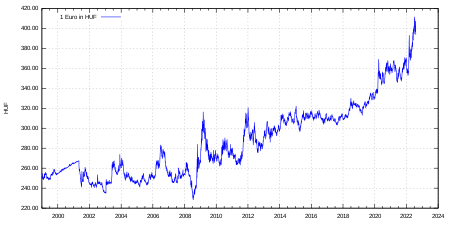Hungarian forint
| Magyar forint (Hungarian) | |
|---|---|
 Hungarian forint banknotes | |
| ISO 4217 | |
| Code | HUF (numeric: 348) |
| Subunit | 0.01 |
| Unit | |
| Plural | forintok (nominative only) |
| Symbol | Ft |
| Denominations | |
| Subunit | |
| 1⁄100 | fillér (defunct) |
| Banknotes | 500 Ft, 1,000 Ft, 2,000 Ft, 5,000 Ft, 10,000 Ft, 20,000 Ft |
| Coins | |
| Freq. used | 5 Ft, 10 Ft, 20 Ft, 50 Ft, 100 Ft, 200 Ft |
| Demographics | |
| Date of introduction | 1 August 1946 |
| Replaced | Hungarian adópengő |
| User(s) | |
| Issuance | |
| Central bank | Hungarian National Bank |
| Website | www |
| Printer | Hungarian Banknote Printing Company |
| Website | www |
| Mint | Hungarian Mint Ltd. |
| Website | www |
| Valuation | |
| Inflation | 3.8% (January 2024) |
| Source | www |
| Method | CPI |
The forint (
History
This section needs additional citations for verification. (February 2015) |

The forint's name comes from the city of Florence, where gold coins called fiorino d'oro were minted from 1252. In Hungary, the florentinus (later forint), also a gold-based currency, was used from 1325 under Charles Robert, with several other countries following Hungary's example.[4]
Between 1868 and 1892, the forint was the name used in
The forint was reintroduced on 1 August 1946, after the
The forint replaced the pengő at the theoretical rate of 1 forint = 4×1029 pengő, thus dropping 29 zeroes from the old currency. In reality, with the highest-value note being 100 million
Historically, the forint was subdivided into 100 fillér (comparable to a penny), although fillér coins have been rendered useless by inflation and have not been in circulation since 1999. (Since 2000, one forint has typically been worth about half a US cent or slightly less.) The Hungarian abbreviation for forint is Ft, which is written after the number with a space between. The name fillér, the subdivision of all Hungarian currencies since 1925, comes from the German word Vierer which denoted a four-krajcár-piece. The abbreviation for the fillér was f, also written after the number with a space in between.[citation needed]
When the forint was introduced, its value was defined on the basis of 1 kilogram of gold being 13,210 forints. Therefore, given that gold was fixed at US$35 per Troy ounce, one USD was at that time worth 11.74 forints.
After its 1946 introduction, the forint remained stable for the following two decades, but started to lose its purchasing power as the state-socialist economic system (planned economy) lost its competitiveness during the 1970s and 1980s. After the democratic change of 1989–90, the forint saw yearly inflation figures of about 35% for three years, but significant market economy reforms helped stabilize it.[citation needed]
Coins
In 1946, coins were introduced in denominations of 2, 10, 20 fillérs and 1, 2, 5 forints. The silver 5 forint coin was reissued only in the next year; later it was withdrawn from circulation. Five and 50 fillérs coins were issued in 1948. In 1967, a 5 forint coin was reintroduced, followed by a 10 forint in 1971 and 20 forint in 1982.
In 1992, a new series of coins was introduced in denominations of 1, 2, 5, 10, 20, 50, 100 and (a somewhat different, 500
Silver 200 forint coins were withdrawn in 1998 (as their nominal value was too low compared to their precious metal content); the 1 and 2 forint coins remained legal tender until 29 February 2008.[8] For cash purchases, the total price is now rounded to the nearest multiple of 5 forint (to 0 or to 5).[9] A new 200 forint coin[10] made of base metal alloy was introduced in place of the 200 forint banknote on 15 June 2009.
Banknotes
In 1946, 10 and 100 forint notes were introduced by the Hungarian National Bank. A new series of higher quality banknotes (in denominations of 10, 20 and 100 forints) were introduced in 1947 and 1948. 50 forint notes were added in 1953, 500 forint notes were introduced in 1970, followed by 1,000 forints in 1983, and 5,000 forints in 1991.
A completely redesigned new series of banknotes in denominations of 200, 500, 1,000, 2,000, 5,000, 10,000 and 20,000 forints was introduced gradually between 1997 and 2001. Each banknote depicts a famous Hungarian leader or politician on the obverse and a place or event related to him on the reverse. All of the banknotes are
Commemorative banknotes have also been issued recently: 1,000 and 2,000 forint notes to commemorate the millennium (in 2000) and a 500-forint note to commemorate the 50th anniversary of the
The 200-forint banknote was withdrawn from circulation in 2009, as its value inflated over time.[11] The banknote was replaced by a bimetallic 200-forint coin featuring the iconic Széchenyi Chain Bridge.[12]
Forgery of forint banknotes is not significant. However, forged 20,000 forint notes printed on the paper of 2,000 forint notes after dissolving the original ink might come up and are not easy to recognize. Another denomination preferred by counterfeiters was the 1,000 forint note until improved security features were added in 2006.
Worn banknotes no longer fit for circulation are withdrawn, destroyed and turned into briquettes which are donated to public benefit (charitable) organizations to be used as heating fuel.[13]
In 2014, a new revised version of the 1997 banknote series was gradually put into circulation beginning with the 10,000 Ft banknote in 2014 and completed with the 500 Ft banknote in 2019.
In 2022 after
Current exchange rates
| Current HUF exchange rates | |
|---|---|
| From Google Finance: | AUD CAD CHF CNY EUR GBP HKD JPY USD TRY |
| From Yahoo! Finance: | AUD CAD CHF CNY EUR GBP HKD JPY USD TRY |
| From XE.com: | AUD CAD CHF CNY EUR GBP HKD JPY USD TRY |
| From OANDA: | AUD CAD CHF CNY EUR GBP HKD JPY USD TRY |
Historic rates
Forints per dollar, euro, etc.
|
Most traded currencies (from 31 December 1990):
Sources: arfolyam.iridium.hu |
Currencies of nearby countries (from 31 December 2010):
Sources: arfolyam.iridium.hu 
|
See also
References
- ^ BBC News Hungary lifts last currency restrictions. 18 June 2001
- ^ "1.1.1.2. Consumer price index by aggregate groups of consumption, and consumer price index for pensioners". www.ksh.hu. Retrieved 16 July 2022.
- ^ Szakacs, Gergely (18 October 2021). "Hungary's new opposition PM candidate wants stronger ties with EU". Reuters. Retrieved 16 January 2022.
- )
- ^ "A stable currency in search of a stable Empire? The Austro-Hungarian experience of monetary union". History & Policy. 19 April 2017.
- ^ "GLOSSARY". www.rev.hu. Retrieved 10 January 2021.
- ^ "An Attempt at a New, Democratic Start: 1944–1946". The Institute for the History of the 1956 Revolution.
- ^ [1] Archived 21 February 2009 at the Wayback Machine 1 and 2 forint coins were withdrawn from use from 1 March 2008.
- ^ [2] Archived 21 February 2009 at the Wayback Machine The sum of total purchases is rounded
- ^ [3] Archived 4 March 2010 at the Wayback Machine The new 200 forint coin
- ^ "Coins to replace 200 forint banknotes". www.mnb.hu. Retrieved 26 March 2022.
- ^ "Coins". www.mnb.hu. Retrieved 26 March 2022.
- ^ Calling for MNB-tender for public benefit organizations (MNB-pályázat közhasznú szervezetek számára)
- ^ a b "ECB euro reference exchange rate: Hungarian forint (HUF)". European Central Bank (in Hungarian). Retrieved 16 July 2022.
- ^ "US Dollar (USD) to Hungarian Forint (HUF) exchange rate history". www.exchangerates.org.uk. Retrieved 16 July 2022.
- Krause, Chester L.; Clifford Mishler (1991). ISBN 0873411501.
- Pick, Albert (1994). ISBN 0-87341-207-9.
Further reading
- Gyula Rádóczy; Géza Tasnádi (1992). Magyar papírpénzek 1848–1992 (Hungarian paper money 1848–1992). Danubius Kódex Kiadói Kft. ISBN 963-7434-11-9.
- Károly Leányfalusi; Ádám Nagy (1998). Magyarország fém- és papírpénzei 1926–1998 (Coins and paper money of Hungary 1926–1998). Magyar Éremgyűjtők Egyesülete, Budapest. ISBN 963-03-6023-3.
- Károly Léányfalusi; Ádám Nagy (2006). Magyarország fém- és papírpénzei 1946–2006 (Coins and paper money of Hungary 1964–2006). Magyar Éremgyűjtők Egyesülete, Budapest. ISBN 978-963-7122-16-3.
- Mihály Kupa id. dr. (1993). Corpus notarum pecuniariarum Hungariae I–II. (Magyar Egyetemes Pénzjegytár) (General Hungarian Banknote Catalog). Informatika Történeti Múzeum Alapítvány, Budapest. ISBN 963-04-3658-2.
External links
- Official Daily Exchange Rates Archive, Hungarian National Bank
- (in Hungarian and English) bankjegy.szabadsagharcos.org (Hungarian banknote catalog)
- (in Hungarian and English) www.numismatics.hu (Roman and Hungarian related numismatic site)
- (in Hungarian) papirpenz.hu (pictures of Hungarian banknotes)
- (in Hungarian) Current HUF/EUR and other rates with charts
- (in Hungarian, English, German, and French) www.eremgyujtok.hu (homepage of the Hungarian Coin Collectors' Society)
- Hungarian banknotes (high resolution pictures, also including old forint banknotes)
- Comprehensive catalog of Hungarian coins
- Hungarian National Bank – "Information on forint banknotes and their security features, and forint coins"
| Preceded by: Hungarian pengő Reason: inflation Ratio: 1 forint = 4×1029 pengő (theoretically) |
Currency of Hungary 1 August 1946 – Concurrent with: adópengő until 30 September 1946 |
Succeeded by: Current |
| Preceded by: Hungarian adópengő Reason: inflation Ratio: 1 forint = 200,000,000 adópengő |

